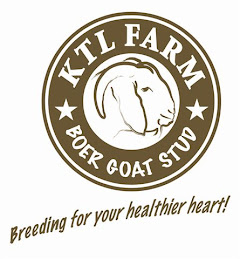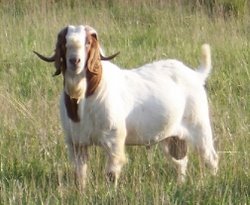(source : http://www.goatindustries.com/goat_meat_world_markets.htm)
A general description of the Boer goat provided by the Boer Goat Association of Australia (1995), is that it generally has a large frame and in color is red headed with a white body. Mature live-weights are between 105 and 135 kg. for males and 90 to 100 kg. for females. Under intensive performance tested conditions, males averaged 36 kg. at 3 months, 72 kg. at 8 months and 100 kg. at 12 months. Females averaged 28 kg. at 3 months and 63 kg. at 12 months. Boer goats are capable of attaining an average daily gain of over 350 grams in feedlot situations. The Boers average daily gain potential on pasture or range-land is outstanding and offers great possibilities for selecting to improve growth rates.
| |
Apart from replacing sheep or cattle in north east Victoria, Boer goats can be complementary. For example, say a farmer was running 6 to 12 dry sheep equivalents (dse's) of sheep or cattle, it would be possible to add one or two dse's of goats per hectare without interfering with the productivity of the sheep or cattle activity. Casey and Van Niekirk (1988), and Glimp (1995) explained that this was possible because goats have different foraging preferences to sheep and cattle and initially tend to utilise the more fibrous of the available plant material. Eventually, as more dse's of goats were added, they would start to compete with sheep or cattle for available pasture and the choice of activities would depend on whichever of the competitive activities was the most profitable. The main point is that graziers could add a small number of goats to their existing farming activities with a resulting increase in the overall profit from the farm.
Markets
According to Holst (1990), the majority of goat meat produced in Australia is derived from feral goats and most of this is exported. In fact, Australia dominates the world trade for exports of goat meat. Basically, demand is for two types of goat meat: Capretto which is milk fed kids with dressed weights ranging from 7 to 10 kilogram, and Chevon which comes from young goats with liveweights between 12 and 25 kilograms.
Table 1 shows the country of destination for exports of goat meat and the number of tonnes exported.
Table 1. Destination and amounts in tonnes for exports of Australian Goat Meat from 1995 to 1998.
| Year | |||
| | 1995 (tonnes) | 1996 (tonnes) | 1997 (tonnes) | 1998 (tonnes) |
| 4,121 | 5,374 | 4,930 | 4,472 |
| 2,359 | 1,955 | 2,999 | 4,002 |
| 1,931 | 1,173 | 1,681 | 1,124 |
| 842 | 997 | 1,228 | 1,280 |
| 839 | 506 | 546 | 506 |
| 155 | 130 | 218 | 178 |
| 819 | 657 | 246 | 53 |
| 286 | 634 | 238 | 21 |
| 74 | 95 | 0 | 11 |
| 12,463 | 12,107 | 11,900 | 10,924 |
From Table 1, the following trends will be noted. There has been a substantial increase in exports to USA, particularly in 1998. Taiwan, Malaysia, and Canada are more or less holding, but declines have been experienced in exports to Carribean countries, Japan, South Korea, Singapore, and destinations in the Middle East. Over the 5 year time period there has been a 12.3 per cent decline in exports.
Exports comprise 85 per cent in carcass form with the remainder being as bone-in and bone-out cuts. In 1998, frozen product amounted to 99.9 per cent of exports with just 7 tonnes being shipped as chilled carcasses to the West Coast of USA, Malaysia and Taiwan.
Market research has shown that there will be an ongoing demand for goat meat in Australia's traditional markets of Malaysia, Singapore, and Taiwan. This market is comprised of both feral and farmed product. However, as the source of feral goats becomes scarcer, the importance of farmed goats will increase. Further, whilst the market from North America is expected to be for delivery on a continual basis, the Asian market will continue to be of a seasonal nature since consumption of goat meat in those countries is often based on demand for religious ceremonies (Department of Primary Industries 1997).
In addition to exporting carcasses and goat meat cuts, Australia is also a major participant in the export market for live goats delivered to the United Arab Emirates. The main competitors in this market are Iran and Somalia.
Market Segmentation
Goat meat producers in north eastern Victoria should target the USA market, particularly the East Coast, which has grown at a faster rate than the West Coast market. One of the key parts of the USA market appears to be the middle class community, who frequently dine out at ethnic restaurants. Success in this will occur through meeting the market's needs with respect to quality, quantity and timeliness of deliveries. The latter will dictate the need to have an agreed policy with a reliable export transport agency.
Market Branding and Positioning
A keen group of goat meat producers should aim to work together in a spirit of co-operativeness. The group should form a strong link in the marketing chain with a known existing exporter of goat meat. Together they should concentrate on supplying the market with high quality, chilled goat meat, probably as prepared cuts. It will be extremely important for market success that the exported product is clearly branded and positioned as being for example derived from the 'sunny gourmet pastures of north east Victoria.'
Market Success
Success will ultimately occur from the various links in the marketing chain having a strong commitment to paying strict attention to meeting the special needs of the market in terms of production, processing, and timely delivery of superior quality goat meat.













